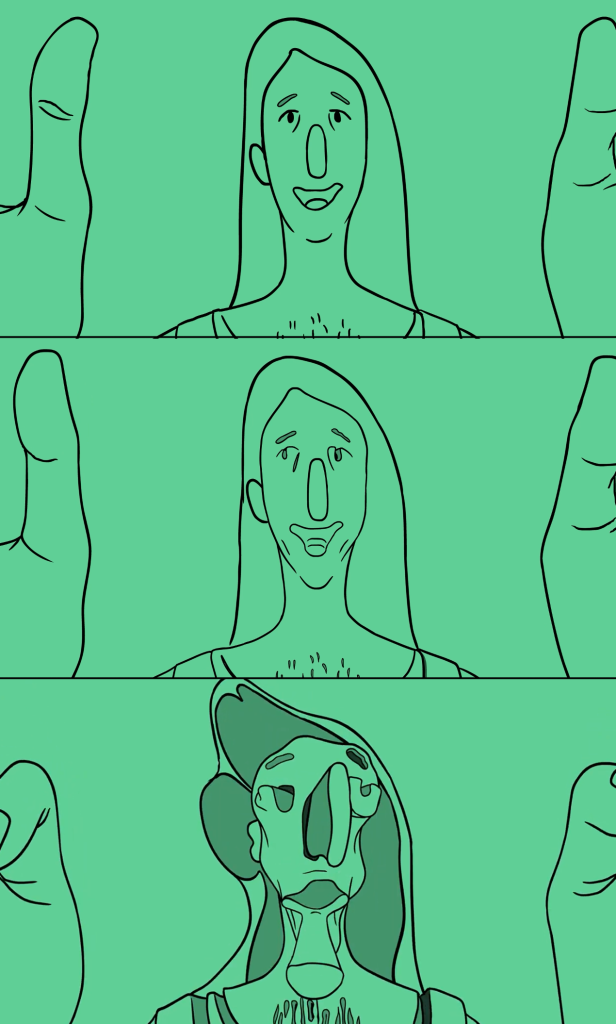Unfortunately, legitimately unsettling cartoon horrors seem to be rare. Semiotically abstracted from reality as they are, flat 2D images can in theory create an intellectual conceptualization of something scary. But they frequently cannot evoke the same immediate visceral experience that naturally (even accidentally) emerges from stop motion and 3D animations (Furniss 2007). This is perhaps why 2D animated horror like Lily C.A.T (1987) and Uzumaki: Spiral Into Horror (2024) tend to scrap 2D animation’s propensity for stretchy characters and ambiguous dimensions, focusing instead on imitating live-action as closely as possible. My 2024 animated horror short Dissimulator aims to circumvent the conventional visual language of animated horror by leaning into 2D animation’s propensity for metamorphosis, its ambiguity of material and its looseness of ontological certainty to create something uniquely creepy.
The short animated horror follows an astronaut searching for water on a desert planet. Led by the signal of a soil sampling robot, she follows it into the depths of a mysterious cave, where she becomes enchanted by a strange living liquid. Suddenly, she finds herself in an abstract green world, where the previously defined outlines around her begin to shift and visually metamorphose. The contents, dimensions, and weights of the objects in this space are plastic, morphing into images of her house and her husband. It is only then that our protagonist realizes she is being absorbed by the liquid creature and that her body’s own outline is coming undone.
Sergei Eisenstein (1986) coined the term “plasmatic” to describe animated characters with total power over their physical form, metamorphosing conveniently or comically on a whim (p. 21). This freedom to reject ossification permits these animated characters to remain formally closer to fluid concepts than to literal material objects. Think of Disney’s early cartoon character Julius the Cat, plucking off his tail and transforming it into a gun to attack a mouse (figure 1). According to Eisenstein (1986), embodying these characters and enjoying their mastery over their body and their world, an audience can escape into a ‘sensuous’, ‘pre-logical’, dreamscape.

But a cartoon character in constant flux with no established default form can quickly make the leap from comically unstable to ontologically frustrating. The villainous liquid creature of Dissimulator (2024) and the strange dream world it creates, have no stable consistent state or dimension. Its outlines threaten to move, change places, swap roles and turn malicious at any time. Here, the infinite possibility of hand-drawn animated movement is being leveraged against our protagonist, not by her. The comfortable, conceptual language of cartoons is disrupted and distorted before our eyes creating total ontological uncertainty, and through it, evoking abjection.
Abjection is a visceral disruption to the norms, categories and rules we use to strictly define the world and ourselves. We feel abject horror, repulsion, discomfort and confusion when these strict boundaries break down, especially with regard to our own bodies (Kristeva 1980). In a largely silent animation with no fill colors like Dissimulator, our sense of definitions and boundaries comes exclusively through outlines. We are forced to rely on these simple barriers, and so when they lose that visual stability, it evokes a confusing hostility toward the creature that made it possible. Insides become outsides, trees become houses and the face of the astronaut’s loving husband becomes stretched and distorted. The viewer’s understanding of the surrounding landscape breaks, sure, but more traumatic still, their reliable visual language for understanding 2D images betrays them (figure 2).

The materials that our protagonist’s body is made of are loosely implied, only separated from the rest of her surroundings by a line. But as the outline of our astronaut’s mouth disconnects and floats away like bubbles underwater, she loses both her ability to scream and her definitive sense of where she begins and ends. 2D animations are free to be as enigmatic as they like in terms of what things are made of, how far away from the camera they are, and precisely where their edges are. Subsequently, they have the potential to access this abject-invoking plasmaticity in ways that are different from 3D and stop motion.
Over the years, Disney moved away from characters like Julius and toward the more morphologically stable Mickey of the 1940s, who could stretch and bend, but within limits that did not break our empathetic connection to his body. (Wells 1998). There was a notable otherness to these overly plasmatic characters, and my intention with Dissimulator was to hone in on that feeling, tease it out, and amplify its disquieting, alienating nature.
Hand-drawn 2D animated films have become less common in the 2024 media landscape, but they can arrive at emotional ends which other mediums struggle to achieve. I dread the idea that these unique capabilities of abstract materiality, plastic dimensionality, and abject plasmaticity should go unexplored to their furthest possible potential before we lose them in popular culture altogether. They may be unsettling, or at times difficult to empathize with, but there’s always a home for those kinds of “flaws” in the horror genre.
References
Eisenstein, S (1986). Eisenstein on Disney. Jay Leyda E.d., translated from Russian by Alan Upchurch. Kolkata: Seagull Books.
Furniss, M (2007) Art in Motion, Revised Edition. Eastleigh: John Libbey Publishing.
Kristeva, J. (1980) Powers of Horror: An Essay on Abjection. Translated from french by Roudiez, L. New York: Columbia University Press.
Wells, P. (1998). Understanding Animation. Oxon: Routledge Press.
Holland Kerr is an animator and MA student currently studying Animation, Gaming and Interactivity (MAGI) at the Royal Melbourne Institute of Technology. She holds two BAs in Visual Communications and English from the University of Tasmania.
